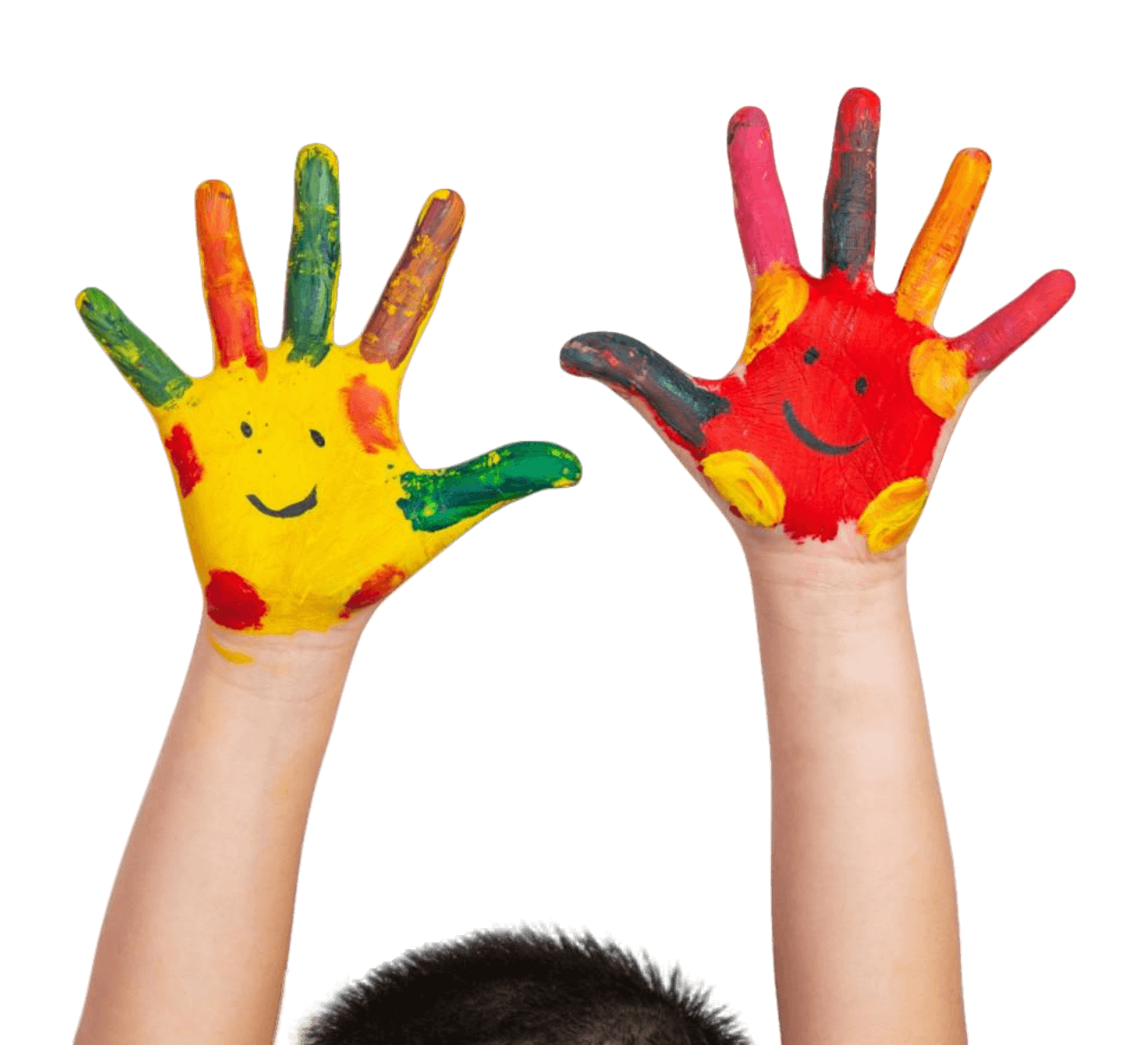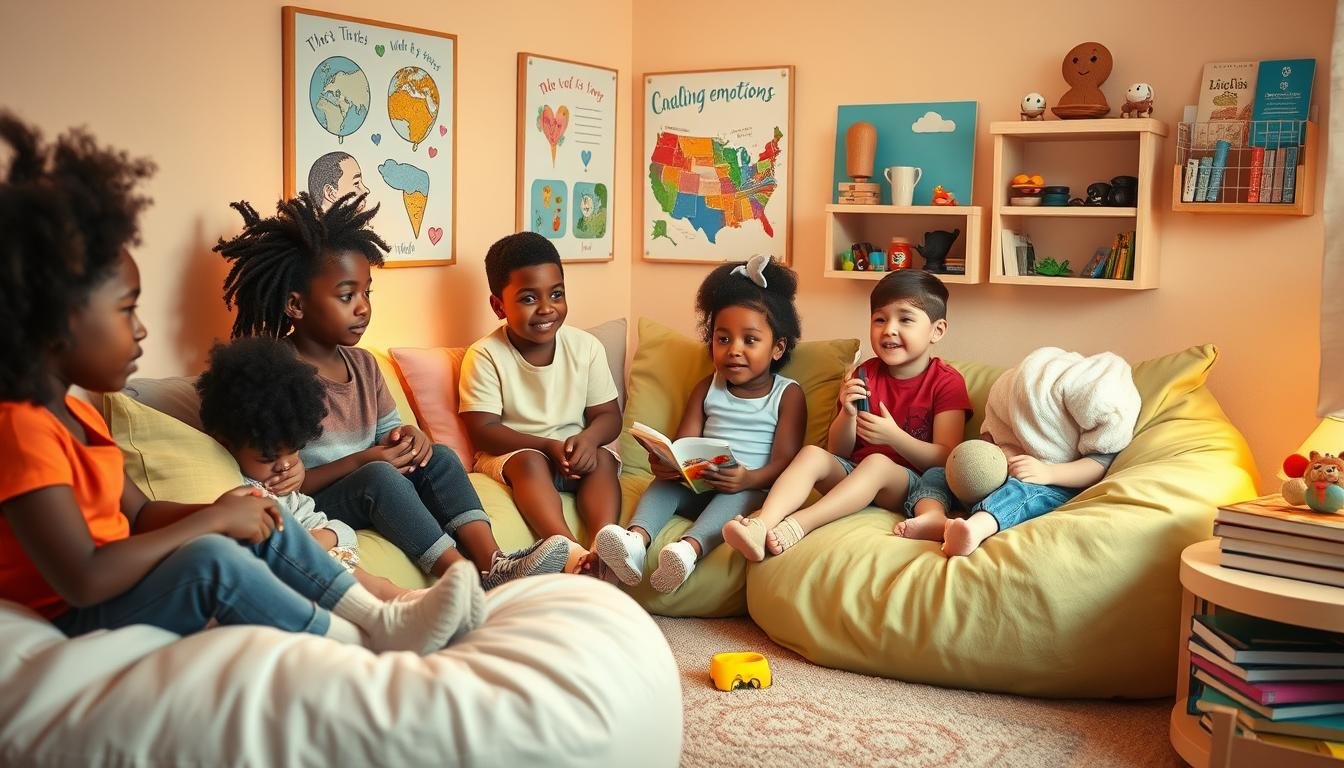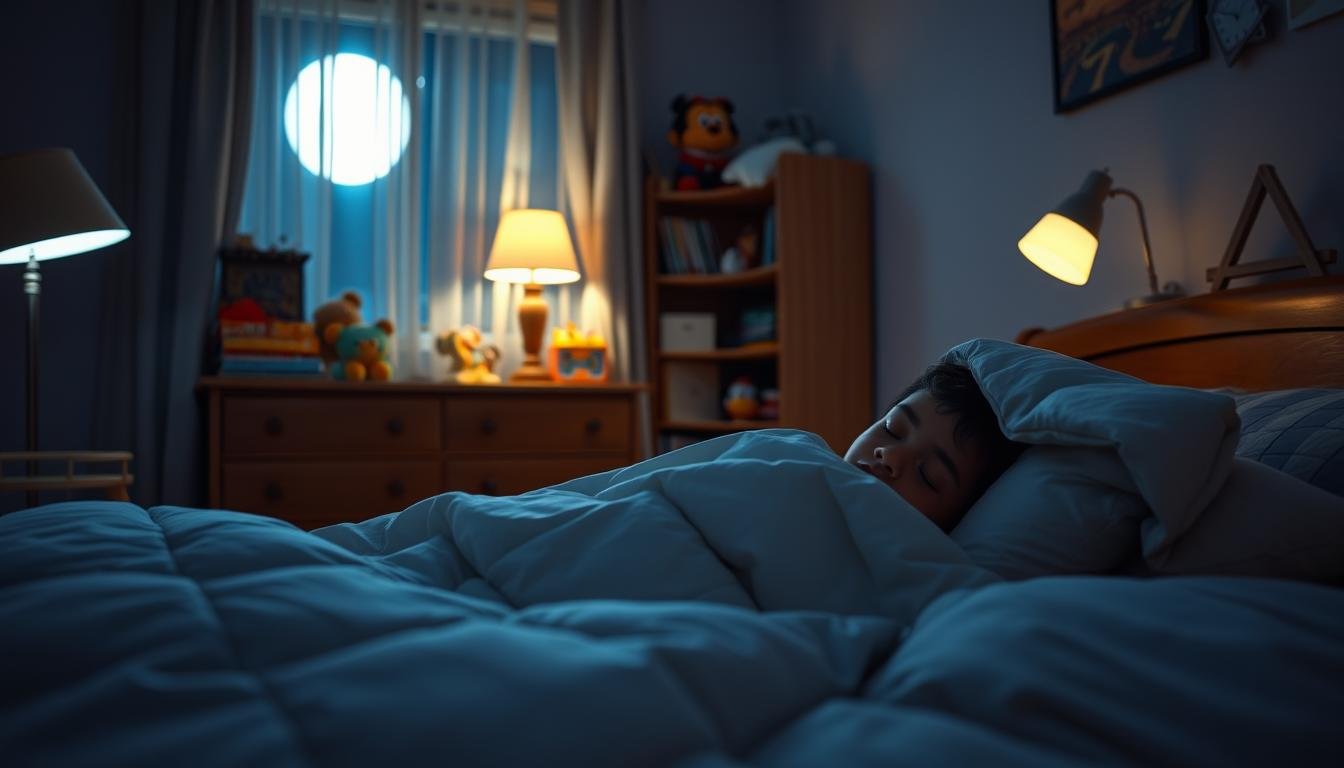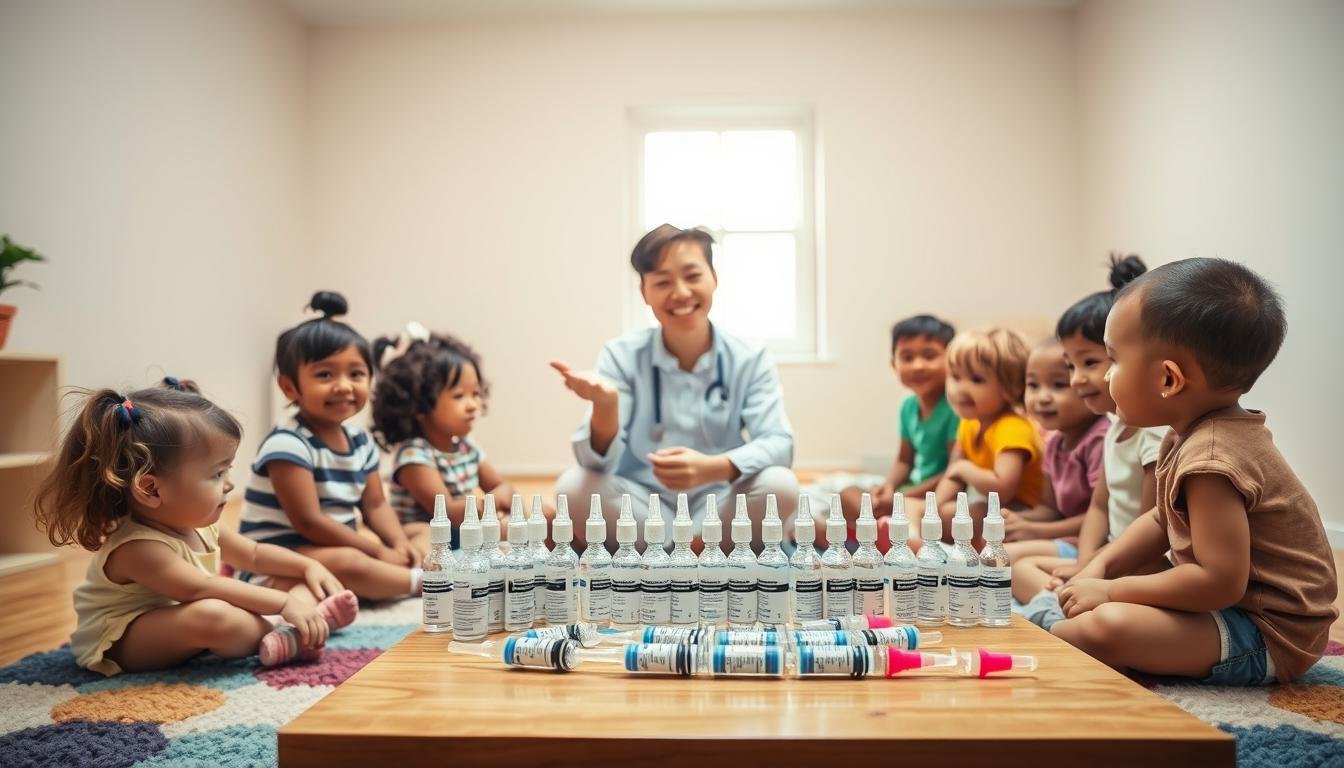Have you ever thought about the power of a simple corner in a room? It can really change how a child feels inside. By looking at creating safe places, we see how important they are in creative expression for kids. This is especially true for kids with special needs, who find comfort and creativity in these calm-down corners.
We know it’s our job to make places where kids feel emotionally supported. Calm-down corners are safe spots for kids to face big emotions, find peace, and get ready to take on the world again. These places are more than just corners. They are areas filled with comfort and tailored to meet our children’s unique needs.
We aim to build spaces that every child can feel comfortable in. We pick out things like weighted blankets and hammock chairs because they help kids feel secure. These spaces encourage kids to be themselves and share their creativity. Making these safe spots can really help kids learn and control their feelings better.
The Importance of Creating a Safe Space for Kids
A nurturing safe space in educational settings is crucial. It’s more than a quiet room—it’s key for keeping emotional safety and helping with emotional regulation in kids. By creating a space that supports them, kids can take a break, come together, and handle their feelings with the right tools and a comforting place.
Building a nurturing safe space goes beyond setting physical limits. It’s about making an environment where kids feel secure and understood. This helps them handle their emotions better, focus more in class, and learn more effectively. They can also share their thoughts freely and without being judged, which is vital for their emotional and psychological growth.
Talking about calm-down corners is common, but actually making such environments requires efforts to foster security and acceptance. Below is a table showing what helps make a nurturing safe space for kids to grow emotionally and learn to regulate themselves.
| Element | Contribution to Emotional Safety | Role in Emotional Regulation |
|---|---|---|
| Color Choices | Soft, soothing colors reduce anxiety and enhance calmness. | Helps children transition into a state of calm, aiding in better emotion management. |
| Comfortable Seating | Provides physical comfort and conveys a sense of belonging and care. | Facilitates engagement in self-soothing practices efficiently, pivotal for self-regulation. |
| Personal Space | Ensures privacy which helps in feeling secure, reducing feelings of exposure or vulnerability. | Allows uninterrupted space to explore coping mechanisms without external judgment. |
The link between these elements and their effect on managing stress and emotions in kids is obvious. Setting up such a space helps kids build resilience and adaptability. These are essential skills for dealing with school challenges and growing personally.
Choosing the Ideal Location for Calm-Down Corners
Finding the perfect spot for a classroom calm-down space is key. It must be effective and comfy for the child. It should be quiet and away from too much action. Yet, it needs to be within the class’s view. Keep these things in mind when choosing.
- Proximity to active areas: Ensure the calm-down corner is not directly in high-traffic zones but is still visible to educators for monitoring and easy access.
- Acoustic considerations: A quieter part of the classroom, perhaps near a corner or a wall that doesn’t carry echoes, can be ideal.
- Visibility: Select a spot that allows for a certain degree of privacy for the students using the space but is not completely isolated from the teacher’s view.
- Lighting: Natural lighting can enhance the soothing quality of the space. A location near a window that isn’t subject to harsh sunlight can help maintain a calming atmosphere.
By using these tips, your classroom calm-down space will be perfect. It offers a peaceful spot for kids to recover emotionally during a busy school day.
Integrating Soothing Colors and Themes
When thinking about calming places for kids, like calm-down corners, we see how important calming colors and peaceful classroom themes are. Choosing the right colors and themes is key to making a space where kids can relax and be at peace. It’s not just for looks; it’s to help kids feel emotionally well.
Blues and greens are known to help reduce stress and bring calm. Picture adding these colors with serene decor for kids. This can turn a simple area into a place of peace. By doing this, we create a space where kids can feel calm and process their emotions.
Learning how art can help kids’ mental health shows the value of serene decor. Art activities not just match the calming colors but also add to the peaceful feel we want.

Using themes that bring a sense of calm in class or at home makes a big difference for kids. By choosing calming colors and serene decor thoughtfully, we support young minds in a calm and safe place.
- Choosing wallpaper or paints in calming colors
- Selecting art supplies that match peaceful themes
- Adding nature and soft textures
These steps help make any learning area calm and focused. It’s more than just decorating. It’s about making a space where kids can grow emotionally and mentally.
Selecting Sensory Elements for Comfort and Focus
Creating a calm-down corner for kids is key. It should include effective sensory tools for sensory regulation support. These tools offer stress relief in kids and are vital for a space where kids can handle their feelings well on their own.
Adding adaptive art tools changes the game for kids who need touch to manage how they feel. These tools make being creative easy for all kids, even those who don’t use a main hand. They help with sensory needs while letting kids express themselves.
- Fidgets for focus: Simple items like fidget spinners or bands help kids stay focused by letting them move.
- Stress balls and sensory bottles: These are great for a calm activity that cuts down on worry and helps kids pay attention.
Adding things like the GoFit Core Medicine Ball and soft toys help with moving skills and give stress relief in kids. Using noise-canceling headphones or soft music makes the corner even more peaceful. It becomes a perfect spot for feeling calm and safe.
Getting kids to touch different textures and materials is good for their senses. It helps them learn to deal with big feelings. By choosing these sensory tools carefully, you make a space that helps kids stay calm and focused. This lets them process and get through tough emotions.
Incorporating Creative Expression for Kids
Art therapy is a strong way for kids to show emotions through creativity. It involves creating a calm art corner for them. Here, they can explore their feelings with art, a universal language. This helps integrate therapeutic practices into their space.
It’s important to have various art supplies for self-expression. Fill this corner with crayons, colored pencils, markers, and lots of paper. Include coloring books that focus on mindful coloring. This activity helps with focus and eases stress. It’s a way to keep kids’ minds busy and calm when they feel too much.
- Watercolor paints for exploring color mixing and texture.
- Clay and playdough for tactile feedback and motor skills enhancement.
- Scissors and glue for crafting and assembly skills, enhancing their ability to follow step-by-step instructions.
These activities offer a safe place for emotional expression through creativity. Every paint and crayon mark lets kids share feelings they can’t put into words. Mindful coloring is an easy path to being mindful. It helps children focus on here and now, one color at a time.
The focus should be on the act of creating and expressing, not the final piece. Art therapy corners should be flexible. This allows kids to express themselves freely as needed. Such freedom is key for their emotional growth and stress relief.
Implementing Comforting Textiles and Seating Options
Designing a calm-down corner in schools means making it comfy. We use cozy seating, soft fabrics, and places to read. These choices help kids feel at ease both physically and emotionally.
- Options like bean bags or comfy chairs let kids find their best spot to relax or read.
- Plush rugs or curtains make the area look and sound softer, shielding from school noise.
- Reading nooks with cushions and blankets create a personal space for book exploration and quiet time.
Understanding student needs is important, so we offer various seating choices. This way, every child finds a spot that’s just right for them.

Different sensory preferences are considered to make everyone feel included and safe. Whether it’s a cushioned seat or a tented nook, each detail helps create a peaceful retreat.
Listening to student feedback helps us improve these spaces. Their input lets us support their emotional and academic growth better.
Using Natural Elements to Enhance Calmness
Bringing nature into the classroom makes it beautiful and helps children feel better. Adding plants creates a peaceful area that helps kids focus and feel less stressed. This green touch turns a corner into a peaceful spot for kids.
By adding elements that look like the outside world, we make the room more relaxing. Using materials like those found outdoors or a small water feature helps. This not only looks nice but also connects kids to nature, helping them grow in every way.
Natural light in classrooms is very important. It does more than just light up the room— it makes moods better, helps mental health, and makes learning easier for kids. Designing spaces to let in lots of natural light is key. Windows offer views outside, giving kids daylight and a visual break to help with their feelings.
Guidelines and Rules for Using the Calm-Down Corner
Creating a calm-down corner in the classroom means thinking about its look and rules. It’s key to have clear rules to keep this area peaceful and useful.
First, students must learn the calm-down corner is for getting calm, not for punishment. They need to know its true purpose to keep the area working right.
Now, let’s talk about calm-down corner etiquette. Here are a few rules to follow:
- Time Limits: We set a time limit—five to ten minutes. This lets everyone have a chance to use the space.
- Expected Behaviors: Students should be quiet or silently use sensory tools while in the corner.
- Care for Tools: It’s important for students to treat the tools gently. This way, they stay good for everyone.
- Space Usage Guidelines: Students need to enter and exit the calm-down corner quietly. This keeps the area peaceful.
These guidelines help the calm-down corner be a peaceful part of the classroom. It supports behavior management by creating a better place for learning.
Sharing and following these rules makes the calm-down corner a valued place. By doing this, all students know they have a special space. This space is for managing emotions and growing personally.
Monitoring Success and Making Adjustments
As teachers, we know how key it is to check how well calm corners work in making better classroom results. We often get thoughts from both kids and teachers to see how the calm-down corners are doing. This input is key for changing emotional learning tools to serve our students’ changing needs better.
Watching how students use these spots gives us great insights into what they like and how useful the tools are. This ongoing effort makes sure the calm-down corners are always getting better, fitting just right for our community.
| Element Evaluated | Initial Feedback | Adjustments Made |
|---|---|---|
| Color Schemes | Too bright, causing overstimulation | Switched to soothing pastels |
| Sensory Tools | Insufficient options available | Added diverse tactile objects |
| Seating Comfort | Chairs were too rigid | Replaced with soft, flexible seating |
To keep improving, we push for ongoing talks between teachers and caregivers. This ensures every change helps make a better learning space. Together, our goal is to keep making our calm-down corners better, always aiming to follow the top advice in educational psychology and child development.
Conclusion
As we look back on our work in creating supportive places for kids, we see the importance of emotional growth. Creating a space for kids to share their feelings helps them learn to handle their emotions. The calm-down corner is a key part of this, helping kids deal with their feelings in a good way.
We’ve talked about making these corners carefully, so they are comforting and interesting. It’s important to find the right mix that fits each child’s needs. Changing the corners as children grow shows we’re committed to their happiness.
For parents needing extra help, Kids Miracle Steps is here to help. They work to empower parents and build a caring community. Kids Miracle Steps offers special help to make kids emotionally stronger and more creative. By working together, we can make a big difference in kids’ lives. They’ll have the tools to face the future with confidence.






